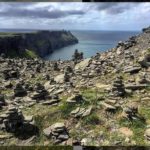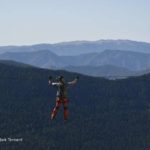Via Ferrata Cascade de la Fraiche
The via ferrata Cascade de la Fraiche is short but climbs alongside a thundering waterfall.? The presence and noise of the waterfall gives an ambiance out of proportion to its length.
The approach to the via ferrata is short from the lovely village of Pralognan-la-Vanoise, a gateway to the Vanoise National Park.? The route starts from large boulders to the left (as you look at the waterfall).? Start by traversing out until you may feel the fine spray from the waterfall, refreshing on a hot summer’s day!? You now climb steeply up overlooking the waterfall hemmed in by steep rock walls.
After this introduction the route heads left and climbs up steep ground and over a couple of overlaps.? Now the Nepal Bridge beckons.? You can either face in, towards the waterfall, or out over the valley.? It’s all in the head as you slide your feet along the single cable holding the two wires above for your hands.? Reaching the other side the route disappears out of sight.? The continuation is enjoyable and finishes steeply to finish amongst pine trees.
Mark’s Opinion
A wonderful route in a wonderful place!? Highly recommended.


